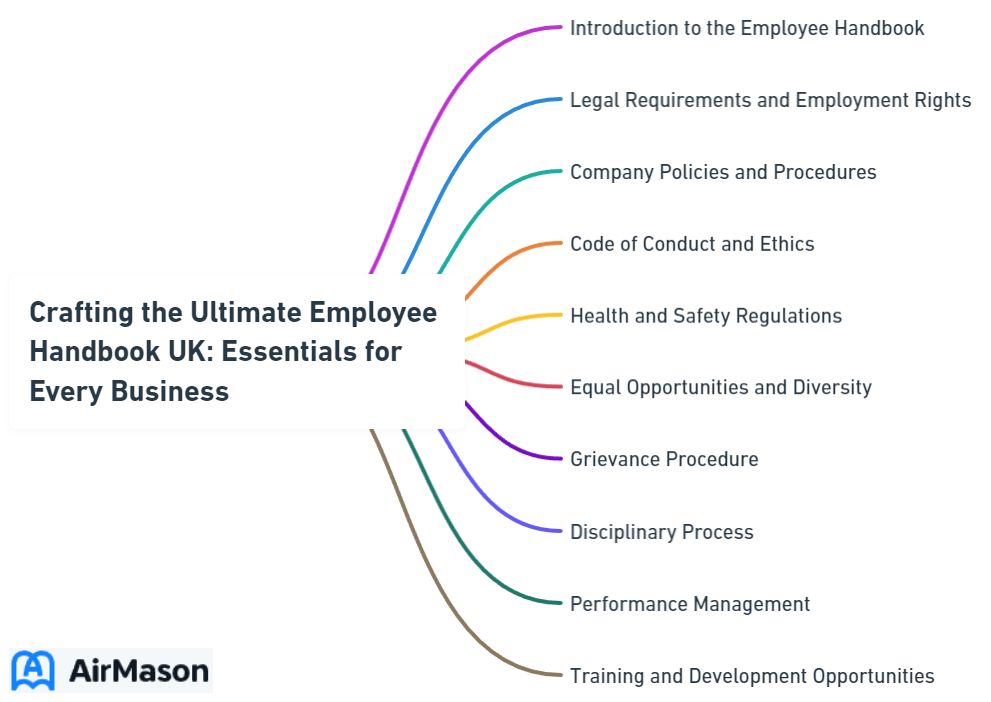
Putting together an employee handbook UK for your business? Get it right with our comprehensive guide that explains the essentials—policies, legalities, and employee guidelines. This article will help you craft a coherent, legally sound manual for workplace wellbeing and regulatory compliance. Dive in to ensure your “employee handbook UK” becomes an invaluable resource for your team.
Key Takeaways
- An employee handbook is crucial in the UK for legal protection, ensuring consistency and clarity, and expressing a company’s values and culture, and must be kept up-to-date with employment law compliance.
- Key components of an effective employee handbook include detailed employment terms, health and safety guidelines, disciplinary and grievance procedures, and equality and diversity policies, which together define workplace expectations.
- The creation and maintenance of an employee handbook require a clear writing style, suitable distribution methods, and regular reviews to ensure the content is current, relevant, and legally compliant.
The Importance of an Employee Handbook in the UK

Given the dynamism of today’s employment landscape, the significance of an employee handbook cannot be understated. Far from being a mere list of rules or a dusty file in a drawer, a well-crafted handbook serves as the backbone of an organization’s culture and operations. It is the go-to guide that provides employees with a clear understanding of their employer’s policies and expectations.
Further, the role of a handbook in the UK is pivotal. The handbook aids legal protection by evidencing employee acknowledgment of the organization’s policies. It helps create uniformity across departments, providing a consistent framework for management.
The handbook also serves as a conduit for expressing the company’s values, policies, and company rules, thereby setting unambiguous expectations for employee behaviour and performance.
Legal Protection
An employee handbook serves dual purposes – guiding employees and bolstering the company’s legal standing. With well-defined policies and procedures that comply with UK employment laws, the handbook serves as proof of the company’s commitment to fairness, transparency, and legal compliance.
The staff handbook acts as a shield in legal proceedings, providing a definitive reference in the event of unfair dismissal claims or other employment disputes. But it’s not just about having a handbook; it’s about having one that’s comprehensive, up-to-date, and compliant with the law.

Consistency and Clarity
Apart from legal protection, an employee handbook cultivates consistency and clarity in the workplace. A well-structured handbook ensures that all employees, regardless of their role or department, have access to the same information, thus promoting fair treatment and preventing discrimination claims.
Moreover, a clear and concise handbook:
- Eliminates ambiguity
- Provides a unified approach to handling various situations within the workplace
- Enhances employee engagement
- Reduces the risk of miscommunication or misunderstanding.
Company Values and Culture
An employee handbook also acts as an effective medium to share a company’s mission, values, and culture. It’s not just about rules and procedures; it’s about who the company is and what it stands for.
By introducing new employees to the company’s ethos, the handbook helps align staff with the company’s culture from the outset. Furthermore, a comprehensive handbook that accurately reflects the unique work culture contributes to a positive work environment and high levels of employee engagement.
Sample Employee Handbook PDF
If you’re seeking a comprehensive guide to crafting your company’s employee handbook, a sample employee handbook PDF can be an invaluable resource. These documents typically offer a structured framework that covers essential policies, procedures, and expectations within an organization. A well-designed sample employee handbook PDF can provide insights into various sections such as code of conduct, benefits, leave policies, and disciplinary procedures. Moreover, it can serve as a reference point for tailoring your handbook to suit your company’s specific needs and culture. Additionally, utilizing a sample employee handbook PDF can save time and effort by offering pre-written templates and language that can be customized to align with your organization’s values and legal requirements. Whether you’re starting from scratch or looking to update your existing handbook, leveraging a sample employee handbook PDF can streamline the process and ensure clarity and consistency across your workforce.
Key Components of an Effective Employee Handbook

Having understood the importance of an employee handbook, the next step is to examine its essential components. An effective handbook goes beyond the basic legal requirements—it provides clear and comprehensive information on a wide range of topics, including:
- Employment terms and conditions
- Health and safety guidelines
- Disciplinary and grievance procedures
- Equality and diversity policies
The goal is to create a well-written, manageable employee handbook that serves as a quick reference guide for employees. However, crafting such a handbook requires a keen understanding of the company’s operations, culture, and legal obligations, as well as a commitment to regular updates and reviews.
Employment Terms and Conditions
Primarily, an employee handbook ought to offer explicit instructions on employment terms and conditions, including those found in an employment contract. This includes general employment information such as:
- job titles
- roles
- responsibilities
- working hours
Other key elements to consider include details regarding:
- working hours
- overtime
- flexi-time
- remote working policies
If any of these terms and conditions change, it’s important to seek employees consent before implementing the changes.
Health and Safety Guidelines
Given the supreme importance of health and safety in any workplace, your employee handbook should mirror this sentiment. Companies with five or more employees have a legal requirement to provide a written statement of health and safety policy.
This policy should cover everything from the appointment of health and safety representatives to implementing safe work procedures and proper equipment usage. And remember, a health and safety policy is not a static document—it needs to be regularly reviewed and updated, particularly when changes to safety laws and regulations occur.
Disciplinary and Grievance Procedures
Another critical element of an employee handbook lies in the disciplinary procedures and grievance policies. These policies establish the procedures for addressing issues internally, ensuring consistency in the treatment of such matters.
Your handbook should outline the process an employer will utilize to address workplace issues, including conducting investigations and suspension protocols during investigations. Additionally, employees have the right to appeal disciplinary or grievance outcomes, and the handbook must provide the procedure to follow for such appeals.
Equality and Diversity Policies
In the current globalized world, the emphasis on equality and diversity has never been higher. Your handbook should feature a policy on equal opportunities to prevent discrimination and promote diversity.
This section of the handbook should detail policies regarding harassment and discrimination based on factors such as:
- gender
- trans status
- marital status
- race
- ethnicity
- disability
- sexual orientation
- religion
- age
It’s also essential to provide instructions for employees on how to proceed if they believe the bribery act policy or any other policies have been breached.
Additional Policies for a Comprehensive Employee Handbook

Apart from the key components mentioned above, a well-rounded employee handbook should encompass other policies as well. These policies—on data privacy and security, time off and absence management, and digital conduct and etiquette—ensure that your handbook covers all bases and provides guidance on a wide range of issues.
These additional company policies not only comply with legal requirements but also reflect current workplace trends and challenges, including employer’s policies on data privacy and security. For instance, in today’s digital age, policies on data privacy and security and digital conduct have become increasingly important.
Data Privacy and Security
In the present digital era, the significance of data privacy and security is paramount. Your employee handbook should include a data protection policy that covers the safe storage and processing of employee data.
Employees have rights regarding access to their personal data, and these rights should be clearly outlined in your handbook. A privacy notice can also be included, setting out:
- how an employee’s personal data is used
- who it will be shared with
- how long it will be kept
- how to lodge a complaint.
Time Off and Absence Management
The management of time off and sickness absence plays a pivotal role in any workplace. Your handbook should include policies on these issues to ensure transparency and consistency.
From managing short and long-term absences to detailing flexible and home working arrangements, your handbook should cover all aspects of time management in the workplace. Detailed procedures for reporting absences and processes for returning to work can facilitate efficient absence management.
Digital Conduct and Etiquette
Given the proliferation of digital technology, your employee handbook must incorporate policies that detail expectations and requirements for staff use of email, the internet, and social media, in compliance with the Information Commissioner’s Office guidelines.
From managing the company’s social media accounts to upholding company standards on personal social media, your handbook should set clear rules for digital conduct. Remember, breaching the social media policy may lead to disciplinary action, so it’s vital that employees are well-aware of these rules.
Creating and Updating Your Employee Handbook

The creation and updating of employee handbooks is an ongoing task. It requires regular review and updates to ensure each employee handbook remains current and legally compliant.
From using clear language and appropriate distribution methods to ensuring the content is engaging and relevant, creating an effective employee handbook requires careful planning and execution. And remember, your employees are your best resource—don’t hesitate to seek their feedback when updating your handbook.
Writing Style and Language
The choice of language and writing style in your employee handbook significantly influences its effectiveness. Clear, concise, and understandable language ensures the handbook is accessible to all employees.
Consider incorporating flowcharts and images to make the handbook more user-friendly and to illustrate processes clearly. Remember, the goal is to create a handbook that’s not just informative, but also engaging and easy to understand.
Distribution Methods
Upon completion of your employee handbook, it must be distributed competently. Whether you publish it as a printed booklet, a PDF document, or host it on an online portal, the method of distribution should cater to different employee preferences and needs.
Remember, the goal is to ensure all employees can find and refer to the handbook easily. Whether they’re working remotely or on-site, your employees should have easy access to the handbook at all times.
Best Employee Handbook PDF
When searching for the best employee handbook PDF, it’s crucial to find a comprehensive resource that covers all essential policies and procedures tailored to your organization’s needs. A well-crafted handbook serves as a vital tool for both employers and employees, outlining expectations, rights, and responsibilities clearly and concisely. The ideal handbook should address key areas such as employment policies, code of conduct, benefits, and disciplinary procedures in a user-friendly format. Additionally, it should reflect the company’s culture and values while remaining compliant with relevant laws and regulations. By providing employees with easy access to important information, a top-notch handbook fosters transparency, consistency, and accountability within the organization. Therefore, investing time and effort into creating or selecting the best employee handbook PDF is essential for promoting a positive work environment and minimizing legal risks.
Regular Reviews and Updates
Maintaining an effective employee handbook calls for regular reviews and updates. Your handbook should be reviewed at least annually, or more frequently if the organization undergoes changes that would affect policies or procedures.
When updates are made, be sure to distribute the updated handbook effectively and ask employees to acknowledge receipt and review. Remember, communicating the reasons and benefits of the updates to employees ensures clarity and buy-in.
Summary
To wrap up, a well-crafted employee handbook serves as a crucial tool in any workplace—ensuring legal compliance, promoting consistency, communicating company values, and serving as a comprehensive guide for employees. Remember, creating an effective handbook requires careful planning, regular reviews, and updates, and most importantly, a commitment to clear communication and transparency.
Frequently Asked Questions
Is an employee handbook mandatory in UK?
No, an employee handbook is not mandatory in the UK, but it can be an efficient tool for companies to communicate their policies and codes of conduct to employees as they grow in size.
What should be included in a staff handbook UK?
In a staff handbook in the UK, you should include an introduction, company background, information on culture and approach to business, hours and conditions of work, pay reviews, policies for holidays, data protection and privacy notices, policies for absences from work, and any relevant industry-specific policies. Beyond that, other important inclusions are overtime and time off in lieu (TOIL).
What is legally required in an employee handbook?
Employee handbooks are not legally required, but state and federal laws mandate providing employees with information such as paid time off, sick leave policies, workplace rights, and protections. This means including these details is crucial in an employee handbook.
Why is an employee handbook important?
An employee handbook is important because it provides legal protection, ensures consistency, clarity, and communication of company values and culture to employees. These factors contribute to a more organized and positive work environment.
What are the key components of an effective employee handbook?
The key components of an effective employee handbook are employment terms and conditions, health and safety guidelines, disciplinary and grievance procedures, and equality and diversity policies. These components are essential for ensuring clarity and fairness in the workplace.
Disclaimer:
Please be aware that the content on this page has been generated by using artificial intelligence language models and may contain errors, inconsistencies, or outdated information.
It is provided as-is without any warranties or guarantees of accuracy. We strongly recommend using this content as a starting point for further research. We disclaim any liability for damages or losses resulting from the use or reliance on this content.